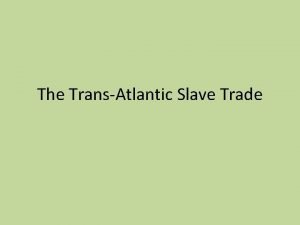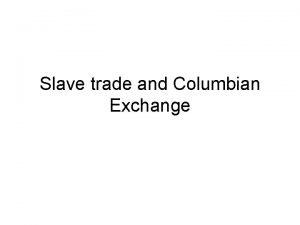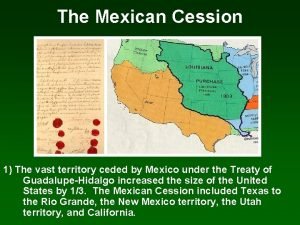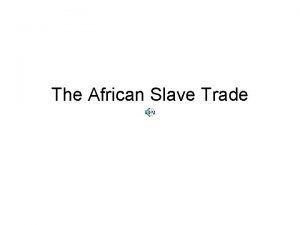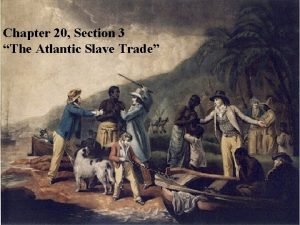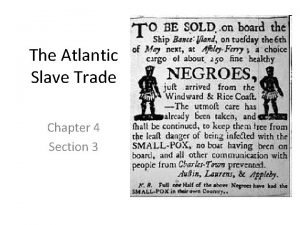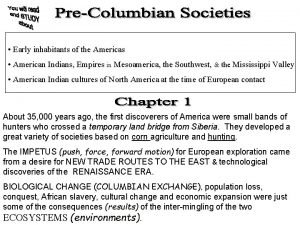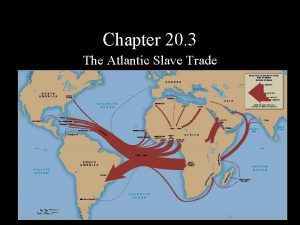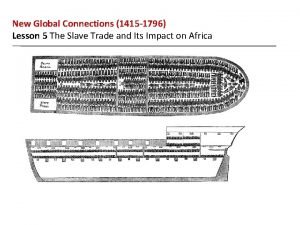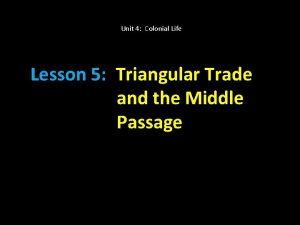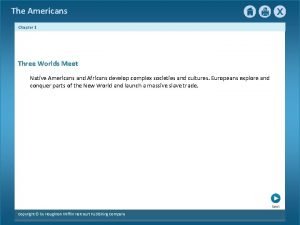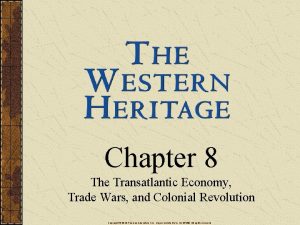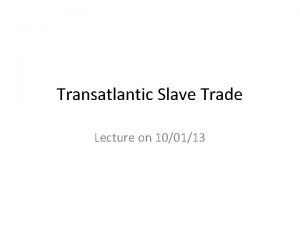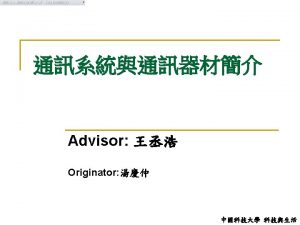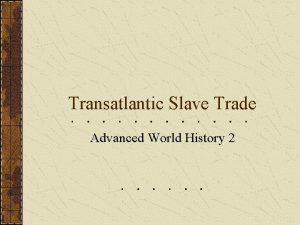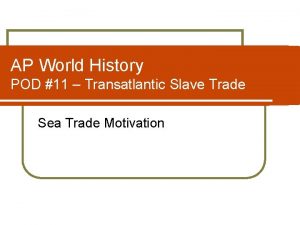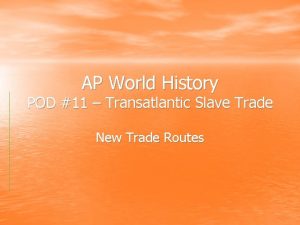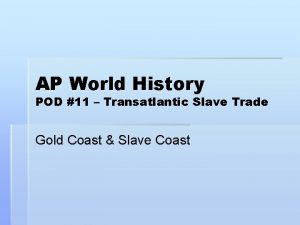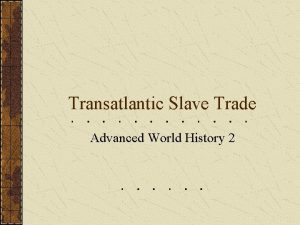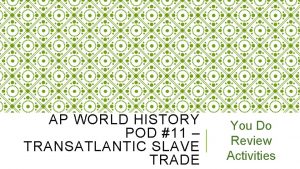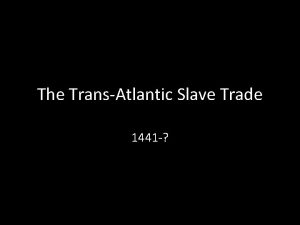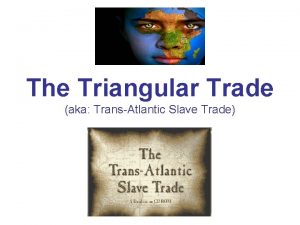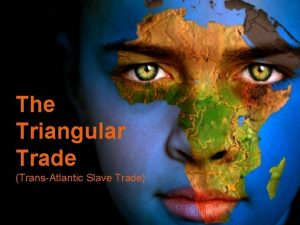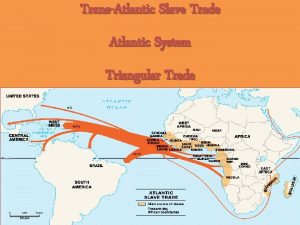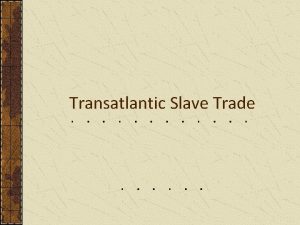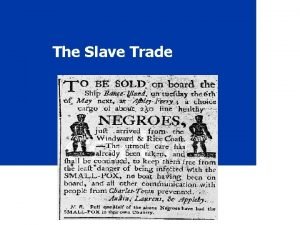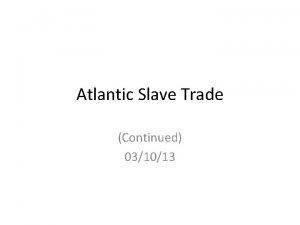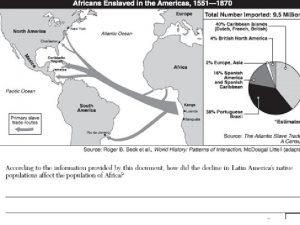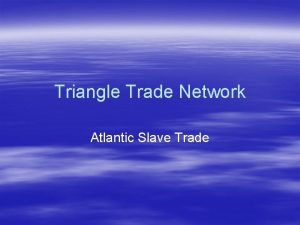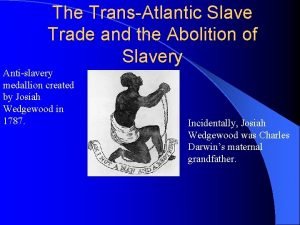Day 84 Transatlantic Slave Trade World History Unit






















- Slides: 22

Day 84: Transatlantic Slave Trade World History Unit 3

Ancient World Civilizations Assyria Babylonia China Egypt India Persia Mesopotamia Slavery was a universal institution in the ancient world but it was a dominant labor force only in a small number of societies. First true slave society - Ancient Greece (6 th to 4 th Century)

Old World vs. New World Slavery Classical world and medieval slavery was not based on racial distinctions. Ancient world did not necessarily view slavery as a permanent condition. Slaves did not necessarily hold the lowest status in early civilizations. Slaves in the old world often were symbols of prestige, luxury and power (true even in the ne world prior to European Colonization).

How was slavery justified? Early civilizations - accident or bad luck.

In Western Civilization…. Aristotle - notion of the “natural slave” “For that some should rule and others be ruled is a thing not only necessary, but expedient; from the hour of their birth, some are marked out for subjection, others for rule”- Aristotle, Politics

Justification in Christianity Christian world - ‘Curse of Ham” ("A servant of servants shall he be unto his brethren. " Genesis 9: 25)

Phrenology 18 th Century European - pseudo-scientific racism.

Why was Africa vulnerable to the Slave Trade? Political Fragmentation Sailing Routes Availability of People (high birth rate) Civilizations and Skills (metalworking, farming, herding) No diplomatic repercussions.

Why not others? Disease Knowledge of terrain Different Agricultural Skills Supply deficit Nation American women worked - not men!

Countries Participating Britain Denmark France Holland Portugal Spain Norway

Why did European powers eventually turn to African labor? Labor supply was insufficient. Epidemics reduced the native population by 50% - 90%. Evidence of deeply help racist sentiment. Racism was a consequence of racial slavery as well as a cause. In English colonies the supply of servants decreased.

Middle Passage Origins of the Infamous Middle Passage The middle leg of a three part voyage. Began and ended in Europe. Carried cargo of iron, cloth, brandy, firearms, gunpowder Landed on Africa’s Slave Coast and exchanged cargo for Africans Set sail for the Americas, where slaves were exchanged for sugar, tobacco, molasses. Final brought the ship back to Europe.

Middle Passage 1600 - 1850’s The Capture Approx. 60 forts build along the west coast of Africa. Walked in slave caravans to the forts some 1000 miles away. Selected by the Europeans and branded. One half survived the death march. Place in underground dungeons until they were boarded on ships.

Middle Passage Conditions on Board the Ship Slaves chained together and crammed into spaces sometimes less than five feet high. Slavers packed three of four hundred Africans into the ship cargo holds. Little ventilation, human waste, horrific odors. Unclean.

Middle Passage Tight packing - belly to back, chained in twos, wrist to ankle (660+), naked. Loose packing - shoulder to shoulder chained wrist to wrist or ankle to ankle. Men and woman separated (men placed towards bow, women toward stern). Fed once of twice a day and brought on deck for limited times.

British Slave Ship

Middle Passage Journey lasted 6 -8 weeks. Due to high mortality rate, cargo was insured (reimbursed for drowning accidents but not for deaths from disease of sickness) Common to dump your cargo for sickness or food shortages. Slave mutinies on board ships were common (1 out of every 10 voyages across the Atlantic experience a revolt). Covert resistance (attempted suicide, jumped overboard, refusal to eat).

Deck for a limited time Often slavers would use fear tactics to keep the slaves from rebelling. If disease was found in slaves they were thrown overboard. Abuse was rampant. Neglect, whipping, malnutrition, sexual abuse, and dehumanization.

Destination of Captives Caribbean Brazil Latin America British North America 50% 35% 10% 5%

Growth of African American Population 1820 1. 77 million 13% free 1830 2. 33 million 14% free 1840 2. 87 million 13% free 1850 3. 69 million 12% free 1860 4. 44 million 11% free

Slave Resistance: Passive and Active Resistance Breaking tools Faking illness Staging slowdowns Committing acts of arson and sabotage Running Away Underground Railroad

Legacy of Slavery Agriculture Rice Sweet Potatoes Herding Basketry Working Style (cooperative labor) Planting (heel to toe) Food Spices (red pepper, sesame, cajun) Okra, black eyed peas Rice Dishes Gumbo, jambalaya Ash and hot cakes Sweet potato pie Music Banjo Drum Blues/Jazz Call and response Spirituals Religion Call and response patterns Emotional services Multiple spirits and souls Voodoo Tales and Words Trickster takes (Anansi the Spider, Brer Rabbit, Bugs Bunny) Words like bogus, bug, phony, yam, tote, gumbo, tater, jamboree, jazz. Creole Language
 What is triangle trade
What is triangle trade Transatlantic slave trade pictures
Transatlantic slave trade pictures Transatlantic slave trade apush
Transatlantic slave trade apush The transatlantic slave trade
The transatlantic slave trade The transatlantic question
The transatlantic question Day 1 day 2 day 3 day 4
Day 1 day 2 day 3 day 4 Transatlantic encounters in history of education download
Transatlantic encounters in history of education download Washington dc slave trade
Washington dc slave trade Atlantic slave trade
Atlantic slave trade Chapter 20 section 3 the atlantic slave trade answer key
Chapter 20 section 3 the atlantic slave trade answer key Chapter 4 section 3 the atlantic slave trade
Chapter 4 section 3 the atlantic slave trade Effects of the slave trade on africa
Effects of the slave trade on africa The atlantic slave trade chapter 20 section 3
The atlantic slave trade chapter 20 section 3 Lesson 5 the slave trade and its impact on africa
Lesson 5 the slave trade and its impact on africa Slave trade primary sources
Slave trade primary sources Destination america
Destination america The age of exploration outcome the atlantic slave trade
The age of exploration outcome the atlantic slave trade The age of exploration outcome the atlantic slave trade
The age of exploration outcome the atlantic slave trade Day 1 day 2 day 817
Day 1 day 2 day 817 Transatlantic tunnel project
Transatlantic tunnel project Gustavus swift inventions
Gustavus swift inventions Chapter 1 three worlds meet answer key
Chapter 1 three worlds meet answer key Transatlantic slaves
Transatlantic slaves

